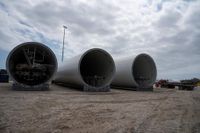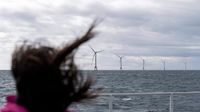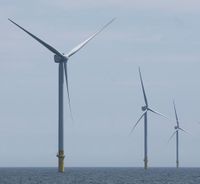Work on the Revolution Wind offshore wind project—poised to become Rhode Island and Connecticut’s first large-scale source of clean energy—has been given the green light to resume after a federal judge blocked the Trump administration’s abrupt effort to halt construction. The decision, issued Monday, September 22, 2025, by U.S. District Court Judge Royce Lamberth, comes as a relief for developers, state officials, and the more than 1,000 workers whose livelihoods hinge on the $6 billion project.
The Revolution Wind project, a joint venture between Danish energy giant Ørsted and Skyborn Renewables, a division of Global Infrastructure Partners, had been more than 80% completed when the Bureau of Ocean Energy Management (BOEM) ordered all offshore construction to stop on August 22, 2025. The stated reason? Unspecified national security concerns. Yet, as Judge Lamberth noted in his ruling, the government failed to provide any new evidence to justify reversing previous approvals that had already considered national security impacts during the years-long permitting process.
“If Revolution Wind cannot meet its deadlines, the entire enterprise could collapse,” Judge Lamberth wrote, underscoring the gravity of the situation. “There is no question in my mind of irreparable harm.” According to the Associated Press, delays were costing the developers up to $2.3 million each day the project was stalled—a financial hemorrhage that threatened to derail a venture already five years in the making.
Ørsted and Skyborn Renewables didn’t take the stop-work order lying down. They filed suit in federal court, arguing that the halt was “arbitrary, capricious, unlawful and issued in bad faith.” The two New England states joined the fight, with Connecticut Attorney General William Tong and Rhode Island Attorney General Peter Neronha launching their own legal challenge. Tong described the judge’s injunction as a “major win” for workers and families, stating, “Every day that this project is stymied is a day of lost employment, another day of unaffordable energy costs, and another day burning fossil fuels when American-made clean energy is within reach.”
Much of the heavy lifting for Revolution Wind is taking place at New London’s State Pier, where workers prepare massive turbine shafts and blades for transport to the assembly site off the coast of Block Island. Once operational, the project is expected to supply 704 megawatts of carbon-free electricity to the New England grid—enough to power more than 350,000 homes and meet about 2.5% of the region’s needs. Power-purchase agreements are already in place with utilities in Connecticut and Rhode Island, promising a future of cleaner, more affordable energy for residents.
But the clock is ticking. As CNBC reported, Ørsted’s senior engineering director, Paul Murphy, warned in court filings that the specialized ships needed to install the turbines are only available for a narrow window. If they leave for other projects and cannot return until at least 2028, the entire timeline collapses. Missing the deadline to begin supplying power by the end of 2026 could force the developers to forfeit “billions of dollars” in revenue and might lead to the project’s cancellation. “Revolution Wind currently has no mechanism for extending those deadlines, and the [power-purchase agreements] would be subject to termination, significantly threatening the financial viability of the entire Project and posing an existential risk to the Project, and thus to Revolution Wind,” Murphy stated.
Monday’s ruling sent a wave of relief through New England’s political circles. Connecticut Governor Ned Lamont, who had tried to negotiate with federal officials to allow work to resume, called the decision “good news on behalf of the consumers and bringing down the price of electricity and honoring a contract with Ørsted that goes back to the first Trump administration.” U.S. Senator Richard Blumenthal was even more pointed, declaring, “The Trump Administration offered no credible facts—not a shred of evidence—to support a continued stop work order that deprives thousands of workers of jobs and Connecticut consumers of more affordable energy. None of the government’s trumped-up arguments have factual or legal weight.”
Environmental advocates also celebrated. Kate Sinding Daly of the Conservation Law Foundation praised the court for “upholding the rule of law and rejecting a reckless attempt to sabotage clean energy progress that will slash bills and toxic pollution.” Nancy Pyne of the Sierra Club echoed the sentiment, saying the ruling “reaffirms that Donald Trump and his administration’s attacks on clean energy are not only reckless and harmful to our communities, but they are also illegal.”
The Trump administration, for its part, has made no secret of its skepticism toward offshore wind. Since returning to the White House, President Trump has moved to halt or slow wind development nationwide—revoking permits, pausing new leases, and even stopping hundreds of millions in federal funding for wind projects. Interior Secretary Doug Burgum, speaking at the Gastech conference in Milan earlier this month, was blunt: “Under this administration, there is not a future for offshore wind because it is too expensive and not reliable enough.” Trump, meanwhile, has argued that boosting fossil fuel production is the path to the lowest-cost energy and electricity for the U.S., even as critics say such moves undermine efforts to combat climate change.
The legal battle over Revolution Wind is not quite over. The Department of the Interior, through spokesperson Elizabeth Peace, said the agency “remains committed to ensuring that prior decisions are legally and factually sound” and will continue to investigate potential national security and other concerns as work resumes. The administration has not yet indicated whether it will appeal Judge Lamberth’s ruling, leaving a cloud of uncertainty over the project’s final fate.
For now, though, Ørsted and Skyborn Renewables are moving quickly to get construction back on track. “Revolution Wind will resume impacted construction work as soon as possible, with safety as the top priority,” the company said in a statement. The developers also pledged to “work collaboratively with the US Administration and other stakeholders toward a prompt resolution” of the ongoing lawsuit.
Rhode Island, already home to the pioneering Block Island Wind Farm, is eager to cement its reputation as a leader in offshore wind. With Revolution Wind, the region stands to gain not just cleaner energy but also thousands of jobs and a more secure, affordable electricity supply. As the legal wrangling continues, the eyes of the clean energy world remain fixed on New England’s coast, watching to see if this latest victory for wind power will hold.
Monday’s decision restores momentum to a project that, for now, remains a symbol of the high-stakes struggle over America’s energy future—a future balanced between fossil fuels, political wrangling, and the promise of renewables.






